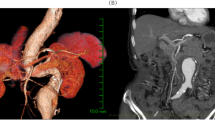Abstract
A 67-year-old man underwent surgical repair for a Crawford extent V thoracoabdominal aortic aneurysm under cerebrospinal fluid drainage and motor evoked potential monitor on distal aortic perfusion. Postoperatively, weakness of right-sided leg graded 2/5 and bladder disorder were recognized. Magnetic resonance imaging revealed hyperintensity between Th11 and L1 on T2-weighted image. Intravenous glycerin and edaravone for spinal cord ischemia had been administered. The strength of right leg resolved completely with disappearance of hyperintensity on magnetic resonance image. Finally, he could walk on foot with bladder disorder.

Similar content being viewed by others
References
Coselli JS, LeMaire SA, Koksoy C, Schmittling ZC, Curling PE. Cerebrospinal fluid drainage reduces paraplegia after thoracoabdominal aortic aneurysm repair: results of a randomized clinical trial. J Vasc Surg. 2002;35:631–9.
Killen DA, Weistein CL, Reed WA. Reversal of spinal cord ischemia resulting from aortic dissection. J Thoracic Cardiovasc Surg. 2000;119:1049–52.
Estera AL, Sheinbaum R, Miller CC, Azizzadeh A, Walkes JC, Lee TY, et al. Cerebrospinal fluid drainage during thoracic aortic repair: safety and current management. Ann Thorac Surg. 2009;88:9–15.
Ortiz-Gomez JR, Gonzalez-Solis FJ, Fernandez-Alonso L. Reversal of acute paraplegia with cerebrospinal fluid drainage after endovascular thoracic aortic aneurysm repair. Anesthesiology. 2001;95:1288–9.
Ye JH, Zhang J, Xiao C, Kong JQ. Patch-clamp studies in the CNS illustrate a simple new method for obtaining viable neurons in rat brain slices: glycerol replacement of NaCl protects CNS neurons. J Neurosci Methods. 2006;158:251–9.
Mamaishi M, Orihashi K, Isaka M, Kumagai H, Takahashi S, Okada K, et al. Low-dose edaravone injection into the clamped aorta prevents ischemic spinal cord injury. Ann Vasc Surg. 2009;23:128–35.
Mawad ME, Rivera V, Crawford S, Ramirez A, Breitbach W. Spinal cord ischemia after resection of thoracoabdominal aortic aneurysm: MR findings in 24 patients. AJNR. 1990;11:987–91.
Conflict of interest
None.
Author information
Authors and Affiliations
Corresponding author
Rights and permissions
About this article
Cite this article
Fukunaga, N., Yuzaki, M., Nasu, M. et al. Reversal of acute monoparesis following thoracoabdominal aortic aneurysm repair. Gen Thorac Cardiovasc Surg 62, 321–323 (2014). https://doi.org/10.1007/s11748-013-0254-0
Received:
Accepted:
Published:
Issue Date:
DOI: https://doi.org/10.1007/s11748-013-0254-0




